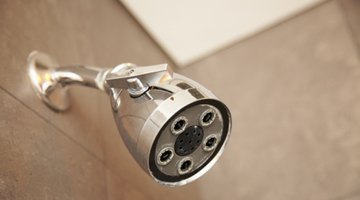How to Paint Shower Stalls With Epoxy
Composed of nonporous materials, such as tile, fiberglass or vinyl, shower stalls are surfaces prone to paint failure. Because paint adhesives are unable to bond with nonporous shower stalls, shedding in the form of chipping or peeling tends to result.

Things You Will Need
- Trisodium phosphate cleanser
- Nylon scrub pad
- Rags
- Professional painter's tape
- Palm sander
- 120-grit sandpaper
- 220-grit sandpaper
- Latex primer
- 5-gallon bucket
- Roller frame
- Nap roller cover
- 4-inch polyester paintbrush
- Epoxy paint
- Wooden stir stick
If you want to paint a shower stall, sand it first to generate a coarser environment more appropriate for adhesion. Because shower stalls are consistently inundated with water, they aren't appropriate for ordinary paint. Choose a lasting epoxy finish, or expect serious paint failure.
Prepare the Stall
-
Wash the stall with a powerful cleanser. Scrub away soap scum, using a coarse nylon pad. Be thorough, or adhesion difficulties will follow. Rinse the stall with wet rags. Let the stall dry for three or four hours.
-
Scuff the stall with sandpaper to promote a rougher surface better suited for primer. Use 120-grit sandpaper on tile stalls. Use 220-grit sandpaper on vinyl/fiberglass stalls.
-
Take the time to carefully cover the outer walls and flooring adjacent to the stall. Cover these areas, along with shower hardware, using painter's tape.
Finishing the Stall
-
Pour 1 gallon of primer into your 5-gallon bucket.
-
Apply primer to the stall, using a roller. Prime one stall wall at a time. Smooth that wall, using a polyester brush. Continue until the entire stall is primed. Let the stall dry for two hours.
-
Wash your bucket and application tools with water.
-
Mix the epoxy catalyst and resin in the bucket. Stir the components together for four minutes.
-
Paint the stall as you primed it. Let the stall dry for three hours.
Warning
If you use a nylon brush to smooth the stall walls, marks will appear in the base and finish. For smooth, attractive results, use a polyester brush.
Warnings
- If you use a nylon brush to smooth the stall walls, marks will appear in the base and finish. For smooth, attractive results, use a polyester brush.
Writer Bio
Ryan Lawrence is a freelance writer based in Boulder, Colorado. He has been writing professionally since 1999. He has 10 years of experience as a professional painting contractor. Lawrence writes for High Class Blogs and Yodle. He has a bachelor's degree in journalism and public relations with a minor in history from the University of Oklahoma.
Photo Credits
- Jupiterimages/Photos.com/Getty Images
- Jupiterimages/Photos.com/Getty Images
More Articles



